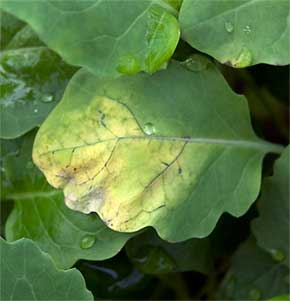Rapid spread of Xanthomonas in brassica transplants
By Roberts SJ, 05 Jan 2007
Modelling the spread of Xanthomonas campestris pv. campestris in module-raised brassica transplants
S. J. Roberts, J. Brough, P. J. Hunter
Plant Pathology Online Early. doi: 10.1111/j.1365-3059.2006.01555.x
Abstract:
A series of experiments was performed to quantify the rate of dispersal of Xanthomonas campestris pv. campestris in module-raised brassica transplants, in a simulated commercial plant-raising system. Seeds were sown in '308' module seed trays and set out in blocks in the glasshouse. Primary inoculum was introduced as inoculated seeds sown in one or more cells. Trays were watered via an overhead-gantry irrigation system, hand-watered or capillary-watered. Disease symptoms were monitored visually and the presence of the pathogen on samples of plants was monitored by leaf washing, dilution and plating on selective medium. Spread of symptoms was greatest in the gantry-watered trays, was very limited in hand-watered trays and was almost non-existent in capillary-watered trays. Dispersal of bacteria followed a similar pattern, but the proportion of plants contaminated was much greater than the proportion showing symptoms, and approached 100% after six weeks in the gantry-watered trays within 50 plants distance from a single primary infector. Models relating the proportion of plants with symptoms, or contaminated, to the distance from primary infector and time since sowing were fitted to the data. Predictions of the proportions of plants contaminated in commercial-scale blocks of transplants suggested that high levels of disease in the field could be explained by rapid rates of pathogen spread during plant-raising, and that the widely-used tolerance standard for seed health testing (0.01%) should be revised to 0.004%. In addition to seed health testing, control should focus on raising transplants under conditions that minimise the rates of disease spread and pathogen dispersal.
Tags: Xcc; Xanthomonas campestris pv. campestris, paper
